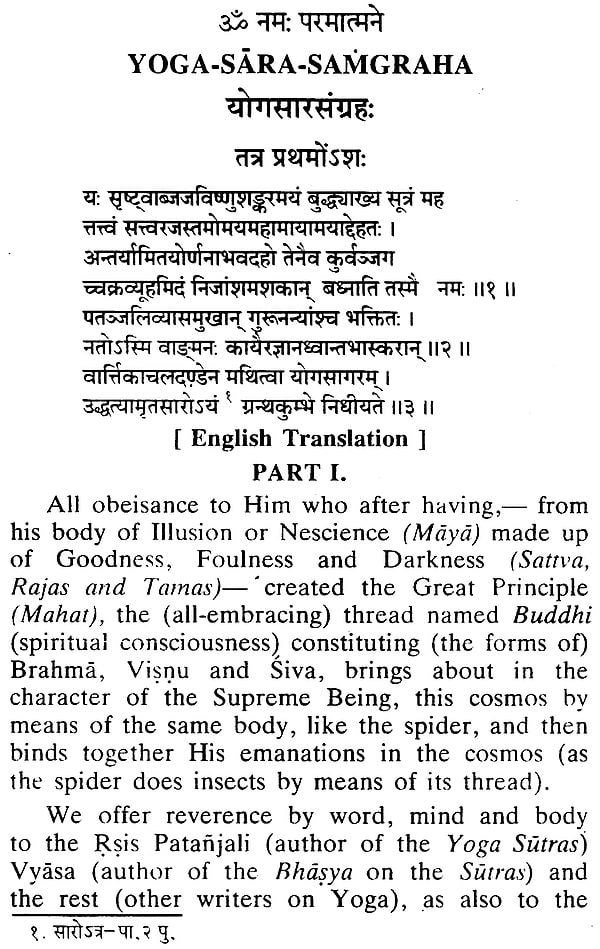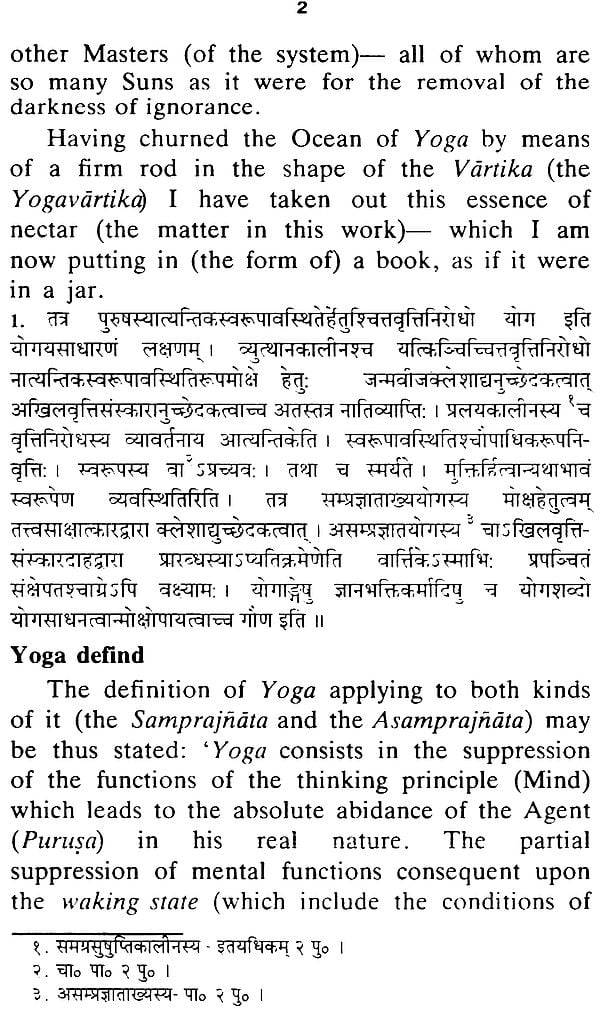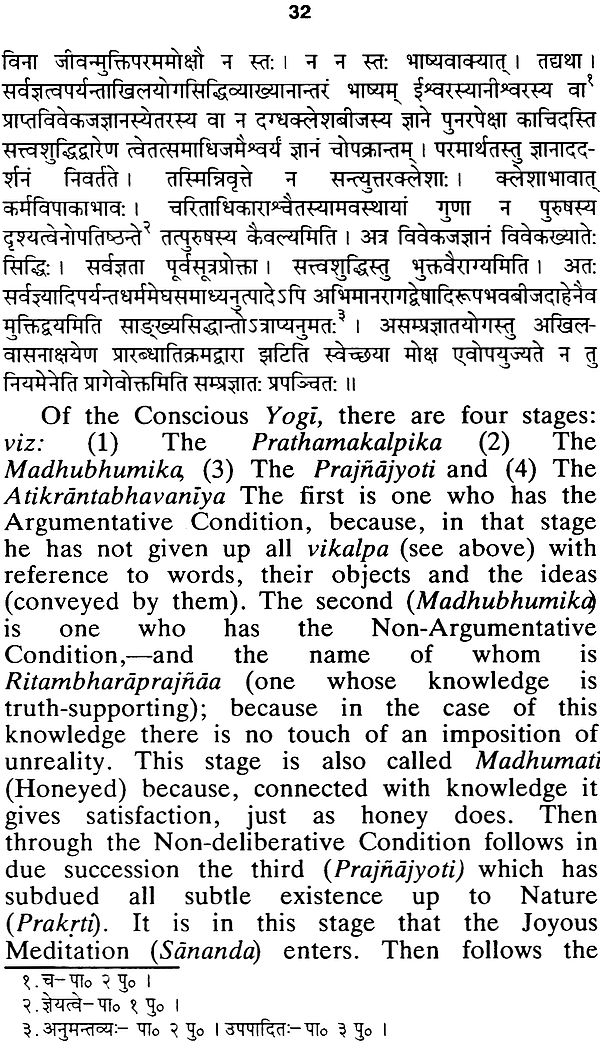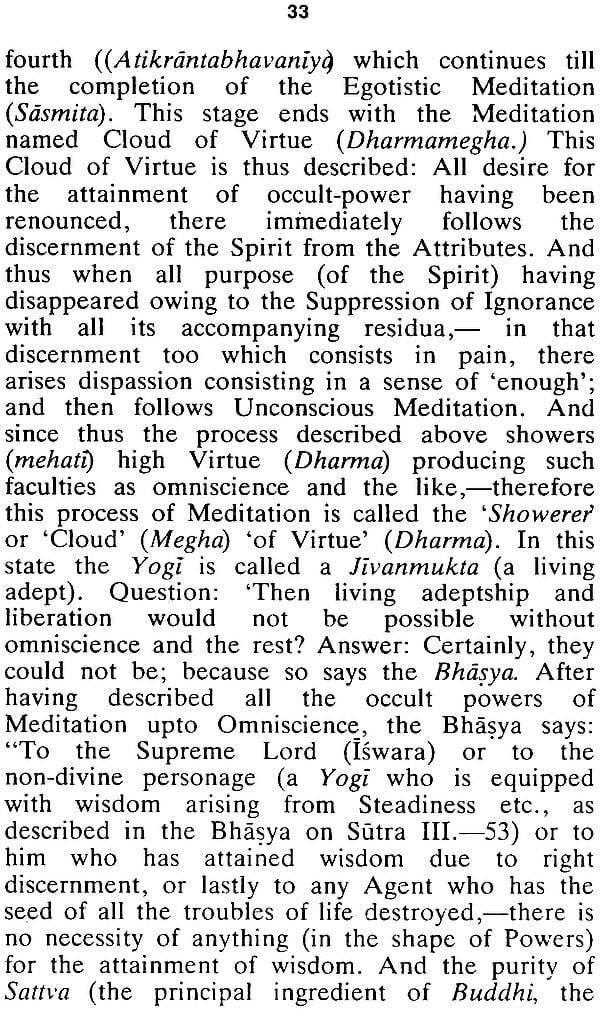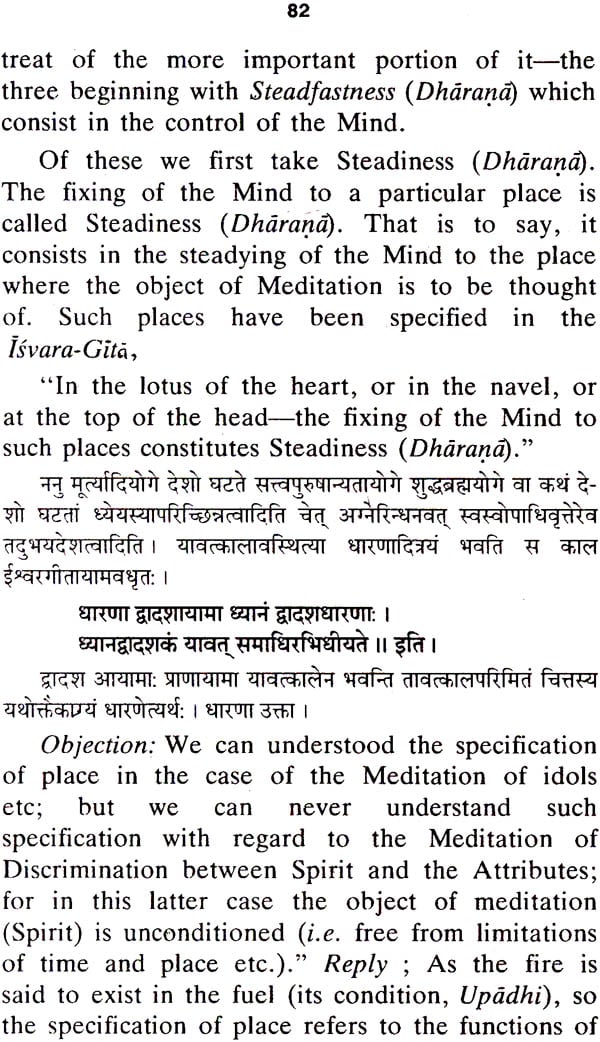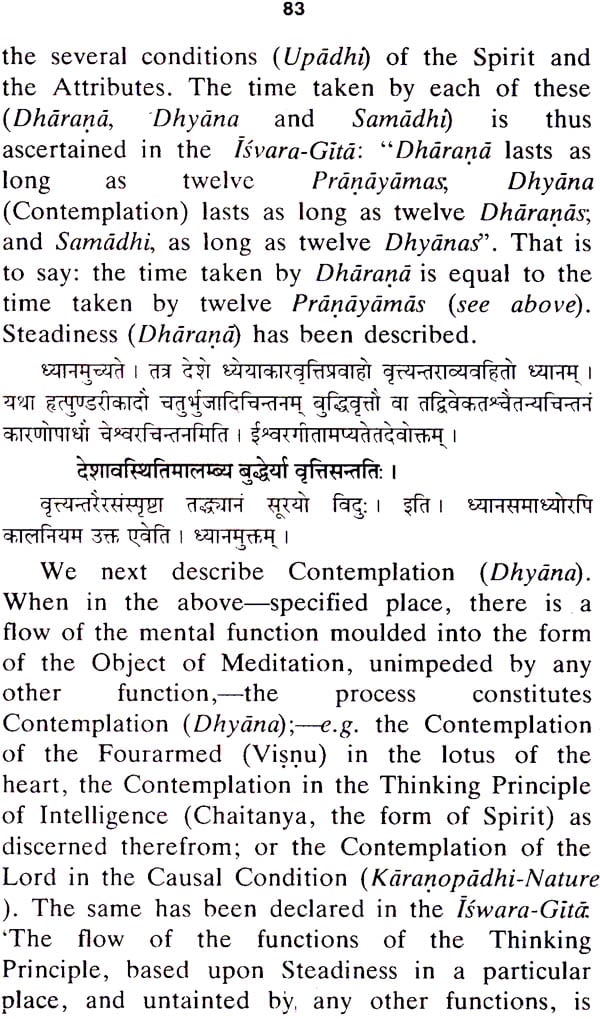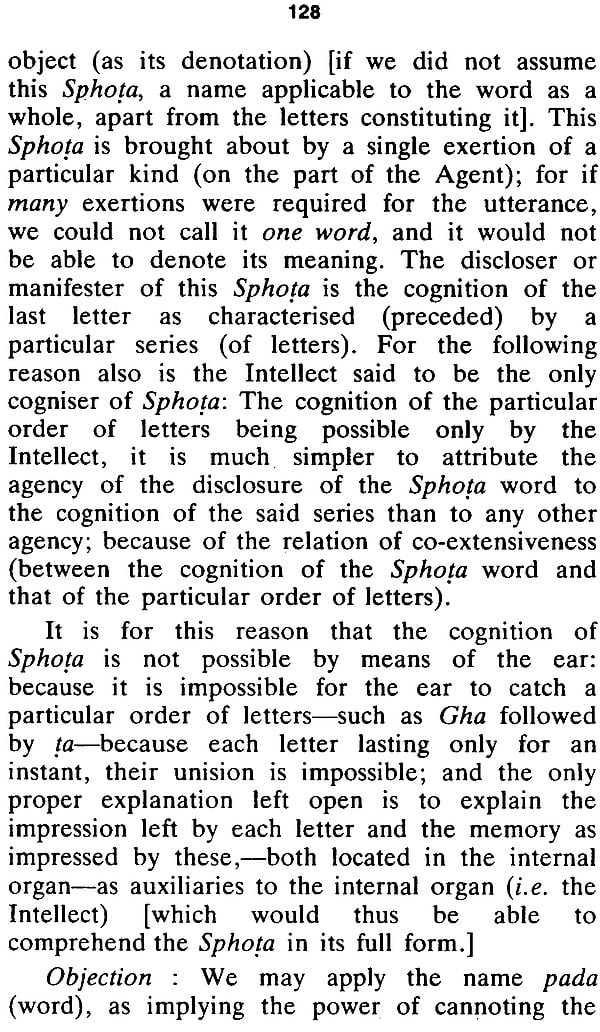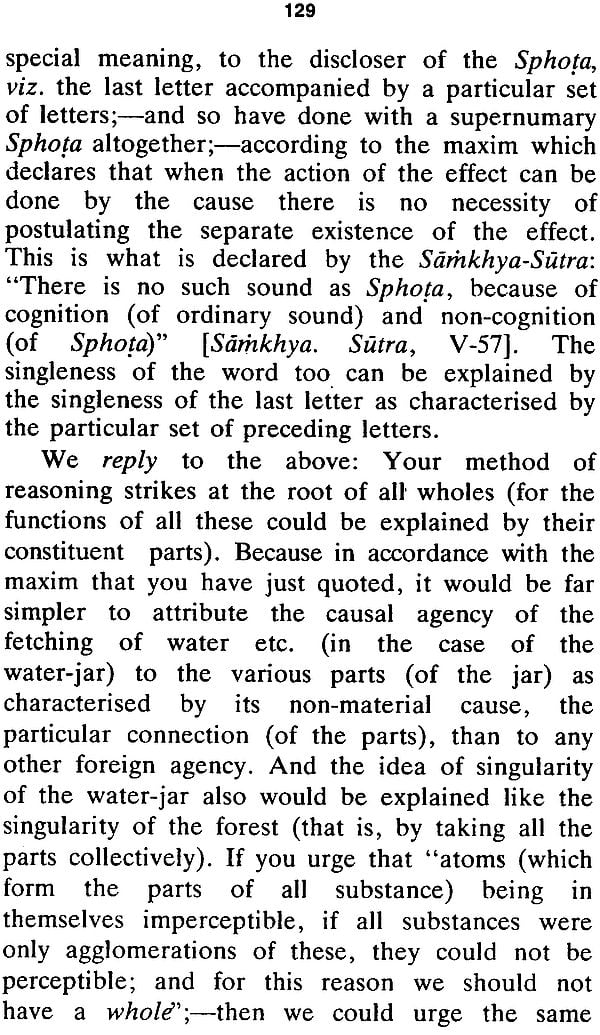
Yoga - Sara - Samgraha of Vijnanbhiksu
Book Specification
| Item Code: | IDF462 |
| Author: | Ganganath Jha |
| Publisher: | Parimal Publication Pvt. Ltd. |
| Language: | Sanskrit Text with English Translation |
| Edition: | 2011 |
| ISBN: | 9788171101085 |
| Pages: | 151 |
| Cover: | Hardcover |
| Other Details | 8.6" X 5.8" |
| Weight | 310 gm |
Book Description
From the Jacket:
Yogasarasamgraha is an original work of Vijanabhiksu. It is the form of collected theories of Yogasutras or Yoga treatise. When deities and demons had churned the ocean they used Sumeru mountain as the churning rod in the process. From that churning, nectar came out and lord Visnu kept it in a jar. Likewise, Vijnanbhiksu has accepted Yoga as an ocean and the commentary Yogavarttika as the churning rod. He kept the originating of nectar (subject-matter), which resulted from the process of rumination and study in the shape of a book (Yogasarasamgraha) as if it were in a jar. The verse quoted indicates that in order to obtain the thorough knowledge of Yoga-sutras and the bhasya on them Vijnanabhiksu wrote a commentary named Yogavarttika. On the basis of that very commentary, the essence of Yoga has been collected, which is known by the name of Yogasarasamgraha.
The present work is revised edition of earlier one. This contains Sanskrit Text and English translation by a learned scholar, Pt. Ganganath Jha. This study embodies the essence of Yoga-vartika by Vyasabhasya which is a commentary to the Yogasutras of Patanjali. The sutras that were systematically presented by Patanjali have been elucidated by Vijnanabhiksu in this study in a language and style that is easily understandable. A number of extracts that has been quoted here from Smriti, Sruti, and Puranas reveals the depth of knowledge in Vijnanabhiksu.
Acarya Vijnanabhiksu was a scholar of independent ideas. He belonged to the 16th Century A.D. (between 1525-1580). His published works are Samkhyapravacanabhasya on the Samkhyasutras, Yogavdrttika on the vyasabhasya and the Vijnanamrtabhasya on the Brahmasutras, in addition to Samkhyasara and the Yogasarasamgraha Therefore, he was a scholar of all the three schools. viz. Samkhya; Yoga and Vedanta of the Indian philosophy. He propounded the principle of the two Samkhya and Yoga by writing Samkhyasara and Yogasara in a simple and lucid style. He also established coordination between Samkhya and Vedanta. The available Samkhyasutra is told to have been authored by Vijnanabhiksu. Bhavaganesa the author of the Tattvayatharthyadipana was his disciple.
A GLIMPSE OF HIS PHILOSOPHY The ultimate goal is not the end of sorrow but the end of the feeling/experience of sorrow because in the state of emancipation one ceases to experience sorrow, the sorrow itself does not cease to be; it remains in the world and others do suffer from it. It is only the emancipated soul.. who ceases to experience sorrow. The ultimate state of emancipation cannot be a state of bliss as there are neither mind nor mental organs and hence there cannot be any experience of bliss. The self cannot be of the nature of bliss and be at the same time the experiencer of it. The epithet anandasvarupa attributed to the self is, in fact, in the sense of negation of sorrow.
Vijnanabhiksu accepts a gradation among realities. According to him, one is stabler and more real than the other. Since Paramatma is always the same and under no circumstances changes/transforms/dissolves, he is more real than the prakrti or Purusa or the evolutes of prakrti. The world does not emanate directly from Brahman as pure consciousness nor are the kala, prakrti and purusa derived from Brahman through transformatory changes (parinama). Had the world come into being directly from Brahman, evil and sins will have to be accepted as having come directly from him. With the association of sattva through the beginningless will of God at the beginning of the previous cycles, the Brahman behaves as lsvara and brings into actual being the prakrti and the purusa, which are already potentially existent in God and connects the prakrti with the purusa. The moment of God's activity in bringing out the prakrti and the purusa may be considered as kala. In this sense, kala is often regarded as the dynamic agency of God. Although, the purusa in himself is absolutely passive, he has a seeming movement being always associated with -the prakrti, which is ever in a state of movement. Kala, being the dynamic agency of God is naturally associated with the movement of prakrti, because both the prakrti and .the purusa are in themselves passive and are rendered active by the dynamic agency of God. This dynamic agency is otherwise called Kala and as. such it is an eternal power existing in Brahman, like the prakrti and purusa. In all other forms of actual existence, Kala is determinate and conditioned and as such non-eternal and to some extent imaginary. It is only the eternal power that subsists in and through all the operations of dynamic activity that Kala may be called eternal. God remains within all as the inner controller and everything is revealed to His super consciousness. God is all pervasive because He is the cause of all and also because He is the inner controller. Bhakti consists in the whole process of listening to God's name, describing His virtues, adoration to Him and meditation leading ultimately to true knowledge. These all are the service of God. Thus, Vijnanabhiksu urges on the doctrine of bhakti as love as a way to the highest realization.
The self is regarded as being itself untouchable and devoid of any kind of association (asanga). The association between prakrti and purusa is only as transcendental reflection through the conditioning factors, which make the pure soul behave as a phenomenal self or Jiva. The self has no knowledge as its quality or character and is in itself pure consciousness and there is at no time an end to this consciousness, which exists even during dreamless sleep. But in dreamless sleep there is no actual knowledge as there is no content present at that time and it is for this reason that the consciousness, though present in the very nature of the self cannot be apperceived. The vasanas or desires existing in the antahkarana cannot affect the pure soul, as at that time the .antahkarana remains in a dissolved condition.
ON SAMKIIYA AND YOGA
Samkhya opines that the prakrti is the original cause and does not say anything about God. The atheistic part of the Samkhya has no authoritative support either in the Vedas or in the Puranas, and has, therefore, to be regarded as invalid. It is wrong, however, to suppose that Kapila really intended to propagate atheism. He quoted atheistic arguments from others and narrated that even if God was not accepted, moksa could be obtained by differentiation of Prakrti from Purusa. The Samkhya also emphasizes the fact that emancipation can be obtained merely by knowledge and this in no case be taken as against those Upanisads, which declare that emancipation can be obtained only by the true knowledge of God. They clearly indicate that there are two ways of attaining moksa, the inferior one being through knowledge of the distinction of prakrti and purusa and the superior one through the true knowledge of God. The Yoga also shows two ways of emancipation-the inferior being through the ordinary Yoga process and the superior one through the renunciation to God of all actions and through devotion to Him. It will also not be just to suppose that the Samkhya is traditionally atheistic for in the Mahabharata (Santiparvan 318.73) and the Matsya Purana (4.28), we hear of a twentysixth category, the God. So the difference between the theistic and the atheistic Samkhya is due to the difference of representation as the true Samkhya doctrine and the Samkhya doctrine, which proposes to ensure emancipation even for those who are not willing to believe In God. Here, according to Vijnanabhiksu, there should be two different schools of Samkhya-one accepting lsvara and the other not admitting it and the later one is invalid according to him. In any case, Vijnanabhiksu says that the Samkhya doctrine is definitely supported by Upanisadic texts.
About Yoga also it can be said that only the part of it may be considered as opposed to the Upanisads, which holds a separate and independent existence of prakrti as apart from lsvara. In the sutras of Patanjali , it is said that God helps the movement of the prakrti only by removing the obstacles. But Upanisads definitely say that God is the generator of the movement and the disturbance of the prakrti. Prakrti is not regarded by Patanjali as the upadhi of lsvara. Vijnanabhiksu explains this part of Yoga doctrine in the same way, he did with the Samkhya by accepting the so called abhyupagamavada. He holds that according to the Yoga the prakrti is independent and runs into evolutionary activity by herself, undetermined by the eternal knowledge and will of God and in the beginning of the creation, prakrti is transformed into the 'sattvopadhi of ,God, even then one can attain Kaivalya by self abnegations to God. Thus, in the Yoga view, the Upadhi of, lsvara is a product and not the material or the instrumental cause of the world, whereas in the Vedanta, the Upadhi of lsvara is both the material and the instrumental cause of the world and this Upadhi, which forms the material stuff of the world is prakrti herself and not her product. In the Yoga view, God is eternal but His thought and will are not eternal. This thought and will are associated with the sattva part of prakrti, which lies embedded in it at the time of pralaya. God in the view of Yoga, is thus, not both the material and the instrumental cause of the world as in the Vedanta.
YOGASARASAMGRAHA
Yogasarasamgraha is an original work of Vijnanabhiksu, It is in the form of collected theories of Yogasutras or Yoga treatise. In the beginning of the work he says :
When deities and demons had churned the ocean, they used Sumeru mountain as the churning rod in the process. From that churning, nector came out and lord Visnu kept it in a jar. Likewise, Vijnanabhiksu has accepted Yoga as an ocean and the commentary Yogavarttika as the churning rod. He kept the originating of nector (subject-matter), which resulted from the process of rumination and study in the shape of a book (Yogasarasamgraha as if it were in a jar. The verse quoted indicates that in order to obtain the thorough knowledge of yoga-sutras and the bhasya on them Vijnanabhiksu wrote a commentary named Yogavarttika On the basis of that very commentary, the essence of Yoga has been collected, which is known by the name of Yogasarasamgraha.
The commentary Yoga varttika is in the sequence of sutras and hence the commentator could not describe the subject matter in its proper order. Consequently, he wrote Yogasarasamgraha in order of the subject-matter. The author has amply supported his statements with various Srutis, Smrtis and Puranas.
It has been written in ordinary and simple Sanskrit. It is in prose and poetry mixed. The main text is in prose but the extracts are generally in the shape of sutras, slokas and bhasyas. On the lines of Patafnali , Vijnanabiksu has collected the essences of Yoga in four divisions and each section has been nominated according to its subject matter.
The form of Yoga and the description of its relevance is the first part. In this section we find the description of ordinary and simple features of Yoga. After that the Vrtti (mental function) and its suppression (Nirodha) have been described. Then Asamprajnata Yoga (Abstract Meditation) and Samprajnata yoga (Concrete Meditation) have been described as the sections of Yoga. The effects of Yoga have also been stated. Stating the sub-divisions of Asamprajnata Yoga, Vijnanabhiksu has also described Vitarka (argumentation), Vicara (deliberation), Ananda (joy) and Asmita (Egotism). Then, he has described the four levels or stages of Yogis. Then, there is the description of asamprajnata Yoga. Describing Upaya-pratyaya the first division of Asamprajnata Yoga, Vijnanabhiksu has given a description of God and His definition. Afterwards there is the description of Bhava pratyaya and in the end the effects of Asamprajnata have been stated.
The. second section deals with the means of Yoga. The internal means first as parikrama etc. of practice for Yoga have been described. Effects of Yoga have been stated extending to liberation. Means of Yoga for Grhastha (house-holders) follow it. Lastly, there is the description of eight means of Yoga, namely- Yama (Restraint), Niyama (Obligation), Asana (Posture), Pranayama (Regulation of breath), Pratyahara (Abstraction), Dharana (Steadiness), Dhyana (Contemplation) and Samadhi (meditation).
The third part of the work consists of the siddhis resulting from Sannyasa: After it, the method of self-revelation or enlightenment has been described. Then, there is an indication of eight types of perception, namely-Anima (Alleviation), Mahimta (Greatness), Laghima (Laxity), Prapti (Attaining by the senses), Prakamya (Irresistible will), lsita (Supremacy), Vasita (Subjection or control) and Kamavasayitva (Fulfilment of desires). The physical properties have also been stated. The perfections and its types have been described.
The fourth part consists of the description of Kaivalya (Isolation, Liberation). Here we find the description of Moksa resulting from Y0ga. In the end the author has described word (Sabda), in which Sphota, the greatness or pervasiveness of the mind and time are described.
Yogasarasamgraha is no doubt among the best works on the Yoga treatise.
| 1. SECTION I | |
| (Form and Aim of Yoga) | |
| Yoga defined | 2 |
| Functions of the thinking principle | 5 |
| Suppression - defined and explained | 7 |
| Two kinds of meditation | 8 |
| Abstract meditation defined | 10 |
| Effect of meditation | 11 |
| Indestructibility of Prarabdha by knowledge | 12 |
| Objection quoting a passage from the Smrti | 14 |
| Four kinds of concrete meditation | 17 |
| Different stages of four kind of concrete meditation | 28 |
| Two fold character of deliberation | 30 |
| 2. SECTION II | |
| (The means of meditation) | |
| Weakening of troubles | 59 |
| Means of meditation | 69 |
| Asana defined | 73 |
| Pranayama | 75 |
| Pratyahara | 81 |
| Dyana - Dharana | 83 |
| Samadhi | 84 |
| 3. SECTION III | |
| (Of the Occult Powers) | |
| Sanyama defined | 96 |
| Eight perfections | 105 |
| Bodily excellence | 107 |
| Perception | 108 |
| Process of accomplishment | 114 |
| Meaning of Egotism | 115 |
| 4. SECTION IV | |
| (Of Isolation) | |
| Superhuman powers | 119 |
| Vedanta theory | 120 |
| Vaisesika theory | 121 |
| Neo- Vedanti's objections | 124 |
| Three kinds of sound | 127 |
| Sphota defined | 128 |
| The Akasas explained | 134 |
